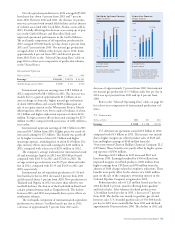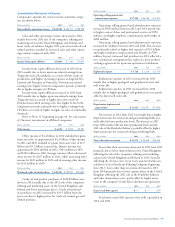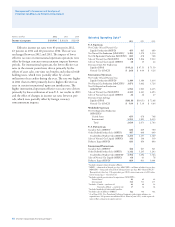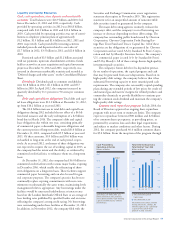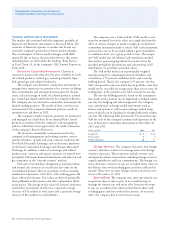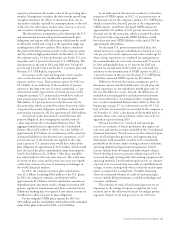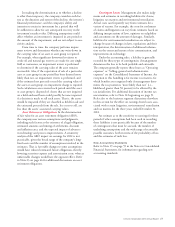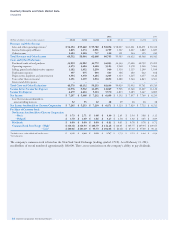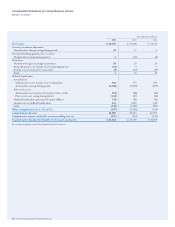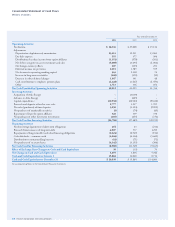Chevron 2012 Annual Report Download - page 27
Download and view the complete annual report
Please find page 27 of the 2012 Chevron annual report below. You can navigate through the pages in the report by either clicking on the pages listed below, or by using the keyword search tool below to find specific information within the annual report.Chevron Corporation 2012 Annual Report 25
expense was based on the market value in the preceding three
months. Management considers the three-month period long
enough to minimize the eects of distortions from day-to-
day market volatility and still be contemporaneous to the end
of the year. For other plans, market value of assets as of year-
end is used in calculating thepension expense.
e discount rate assumptions used to determine the U.S.
and international pension and postretirement benet plan
obligations and expense reect the rate at which benets could
be eectively settled and is equal to the equivalent single rate
resulting from yield curve analysis. is analysis considered
the projected benet payments specic to the company’s plans
and the yields on high-quality bonds. At December 31, 2012,
the company used a 3.6 percent discount rate for the U.S. pen-
sion plans and 3.9 percent for the main U.S. OPEB plan. e
discount rates at the end of 2011 and 2010 were 3.8 and 4.0
percent and 4.8 and 5.0 percent for the U.S. pension plans and
the main U.S. OPEB plans, respectively.
An increase in the expected long-term return on plan
assets or the discount rate would reduce pension plan
expense, and vice versa. Total pension expense for 2012 was
$1.3 billion. As an indication of the sensitivity of pension
expense to the long-term rate of return assumption, a 1 per-
cent increase in the expected rate of return on assets of the
company’s primary U.S. pension plan would have reduced
total pension plan expense for 2012 by approximately
$80million. A 1 percent increase in the discount rate for
this same plan, which accounted for about 62 percent of the
companywide pension obligation, would have reduced total
pension plan expense for 2012 by approximately $165 million.
An increase in the discount rate would decrease the
pension obligation, thus changing the funded status of
a plan reported on the Consolidated Balance Sheet. e
aggregate funded status recognized on the Consolidated
Balance Sheet at December 31, 2012, was a net liability of
approximately $5.9 billion. As an indication of the sensitivity
of pension liabilities to the discount rate assumption, a 0.25
per cent increase in the discount rate applied to the com-
pany’s primary U.S. pension plan would have reduced the
plan obligation by approximately $335 million, which would
have decreased the plan’s underfunded status from approxi-
mately $2.6 billion to $2.2 billion. Other plans would be
less underfunded as discount rates increase. e actual rates
of return on plan assets and discount rates may vary signi-
cantly from estimates because of unanticipated changes in
the world’s nancial markets.
In 2012, the company’s pension plan contributions
were $1.2 billion (including $844 million to the U.S. plans).
In 2013, the company estimates contributions will be
approximately $1.0 billion. Actual contribution amounts are
dependent upon investment results, changes in pension obli-
gations, regulatory requirements and other economic factors.
Additional funding may be required if investment returns are
insucient to oset increases in plan obligations.
For the company’s OPEB plans, expense for 2012 was
$172million, and the total liability, which reected the unfunded
status of the plans at the end of 2012, was $3.8 billion.
As an indication of discount rate sensitivity to the deter-
mination of OPEB expense in 2012, a 1 percent increase in
the discount rate for the company’s primary U.S. OPEB plan,
which accounted for about 82 percent of the companywide
OPEB expense, would have decreased OPEB expense by
approximately $17 million. A 0.25 percent increase in the
discount rate for the same plan, which accounted for about
83 percent of the companywide OPEB liabilities, would
have decreased total OPEB liabilities at the end of 2012 by
approximately $80 million.
For the main U.S. postretirement medical plan, the
annual increase to company contributions is limited to 4 per-
cent per year. For active employees and retirees under age 65
whose claims experiences are combined for rating purposes,
the assumed health care cost-trend rates start with 7.5 percent
in 2013 and gradually drop to 4.5 percent for 2025 and
beyond. As an indication of the health care cost-trend rate
sensitivity to the determination of OPEB expense in 2012, a
1 percent increase in the rates for the main U.S. OPEB plan,
would have increased OPEB expense by $15 million.
Dierences between the various assumptions used to
determine expense and the funded status of each plan and
actual experience are not included in benet plan costs in
theyear the dierence occurs. Instead, the dierences are
included in actuarial gain/loss and unamortized amounts
have been reected in “Accumulated other comprehensive
loss” on the Consolidated Balance Sheet. Refer to Note 20,
beginning on page 57, for information on the $9.7bil-
lion ofbefore-tax actuarial losses recorded by the company as
of December 31, 2012; a description of the method used to
amortize those costs; and an estimate of the costs to be rec-
ognized in expense during 2013.
Oil and Gas Reserves Crude oil and natural gas
reserves are estimates of future production that impact cer-
tain asset and expense accounts included in the Consolidated
Financial Statements. Proved reserves are the estimated quan-
tities of oil and gas that geoscience and engineering data
demonstrate with reasonable certainty to be economically
producible in the future under existing economic conditions,
operating methods and government regulations. Proved
reserves include both developed and undeveloped volumes.
Proved developed reserves represent volumes expected to be
recovered through existing wells with existing equipment and
operating methods. Proved undeveloped reserves are volumes
expected to be recovered from new wells on undrilled proved
acreage, or from existing wells where a relatively major expen-
diture is required for recompletion. Variables impacting
Chevron’s estimated volumes of crude oil and natural gas
reserves include eld performance, available technology and
economic conditions.
e estimates of crude oil and natural gas reserves are
important to the timing of expense recognition for costs
incurred and to the valuation of certain oil and gas produc-
ing assets. Impacts of oil and gas reserves on Chevron’s


